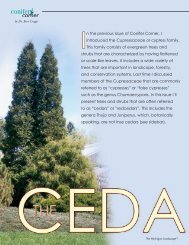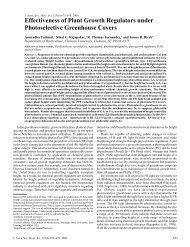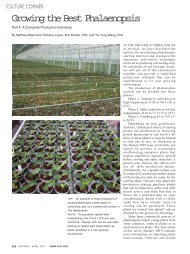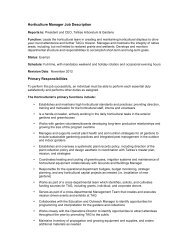Growing the Best Phalaenopsis - Michigan State University
Growing the Best Phalaenopsis - Michigan State University
Growing the Best Phalaenopsis - Michigan State University
You also want an ePaper? Increase the reach of your titles
YUMPU automatically turns print PDFs into web optimized ePapers that Google loves.
CULTURE CORNER<strong>Growing</strong> <strong>the</strong> <strong>Best</strong> <strong>Phalaenopsis</strong>Part 2: Media, Transplanting, Water and Nutrient RequirementsText by Yin-Tung Wang, PhD, Mat<strong>the</strong>w Blanchard, Roberto Lopez and Erik Runkle, PhD/Photographs by Yin-Tung Wang, PhDMANAGING THE ROOT ZONE OFpotted orchids can be one of <strong>the</strong> mostcritical aspects to growing a healthycrop. If one can grow plants withhealthy roots, making <strong>the</strong>m flower is amuch easier task. In this second articleof our four-part series, we presentresearch-based information on howmedium, watering and fertility influencegrowth of potted phalaenopsis.MEDIA COMPONENTS In <strong>the</strong>irnatural habitats, most phalaenopsisspecies are epiphytic plants, meaningthat <strong>the</strong>y grow on tree trunks and limbs.Their roots are exposed to air movementand absorb moisture from <strong>the</strong> humid air,as well as from rains and dews. Becauseof this, when we grow phalaenopsis incontainers filled with an artificialmedium for our convenience, we mustconsider aeration, capillary action,water and nutrient-holding capacities,stability and weight of <strong>the</strong> mediumcomponents, as well as cost andconsistency.Coarse materials are often used toallow for plenty of air movementthrough <strong>the</strong> medium. Ground bark fromDouglas fir and coastal redwood treeshas been used for more than half acentury for growing orchids. AlthoughDouglas fir and coastal redwoodare host plants for Phytophthoraramorum, <strong>the</strong> fungus that causessudden oak death disease in Californiaand Oregon, orchids grown in barkhave been exempt by USDA from <strong>the</strong>quarantine list.Nearly all commercial orchidgrowers make <strong>the</strong>ir own media.Although most modern orchid mediastill contain fir bark, one or more of <strong>the</strong>water-absorptive materials such assphagnum peat, perlite, sphagnummoss, coconut husk chips and diatomiteis mixed with bark for improvedplant growth. For example, earlyresearch at Texas A&M <strong>University</strong>showed that plant growth was vastlyimproved in a medium consisting of 20percent coarse sphagnum peat and 80percent fir bark, compared with fir barkalone.Bark Fresh ground bark does nothold much water, which can be prob-106 ORCHIDS FEBRUARY 2007 WWW.AOS.ORG
CULTURE CORNER242 ppm (with 100 or 200 ppm ofnitrogen) did not influence growth orflowering of phalaenopsis. Preliminaryresearch indicates that 25 to 50 ppmphosphorus is adequate to grow anexcellent crop. Research has shownthat when potting newly imported barerootphalaenopsis for inducing spikingsoon, phosphorus did not affectspiking or flower count during <strong>the</strong> firstflowering season.For growers in cool conditions,consider using a lower fertilizer rateduring <strong>the</strong> flowering cycle due toreduced vegetative growth. Fertilizationcan be withheld completelyonce an inflorescence has reached 10inches (25 cm) in length, or after <strong>the</strong>first flower has opened, withoutaffecting flower count or size.A recently completed study showedthat phalaenopsis that did not receiveadequate levels of potassium mayappear healthy for several months,producing a similar number and size ofnew leaves as those receiving adequatepotassium. As soon as spiking hastaken place and while <strong>the</strong> younginflorescences grow, <strong>the</strong> limited poolof potassium in <strong>the</strong> leaves and roots isremobilized to support <strong>the</strong> reproductivegrowth and <strong>the</strong> lower leaves start toshow symptoms of potassium deficiency.Although plants that weredeficient of potassium producedflowers, a few lower leaves were lost.All phalaenopsis planted in a barkmix and lacking potassium eventuallydied.Continuous application of nitrogenensures flower longevity, but does notincrease flower count after <strong>the</strong> spikeshave reached 10 inches (25 cm) inlength. Results from a recentlycompleted study at Texas A&M<strong>University</strong> suggest that fertilizers highin ammoniacal nitrogen are not desirablefor <strong>the</strong> best vegetative growthand flowering. There has been plenty ofevidence to suggest that phalaenopsisplants must already have had adequatephosphorus and potassium in <strong>the</strong>irtissues prior to spiking for best performance.Potassium at 200 to 300 ppmensures high flower count and maximizesflower size.SALINITY Roots of phalaenopsisare sensitive to salinity and can beinjured when salts accumulate in <strong>the</strong>medium. In one study, when salinity of<strong>the</strong> irrigation water (before adding anyfertilizer) increased from 0 to 1.4 dS/m,root fresh weight decreased. Many110 ORCHIDS FEBRUARY 2007 WWW.AOS.ORG
orchid growers have installed reverseosmosis (RO) equipment to providewater that is low in dissolved salts. Ifstraight RO water is used for irrigationfor extended periods, supplementalcalcium and magnesium must be usedto avoid deficiency problems. Adesirable electrical conductivity (EC)of <strong>the</strong> water before adding fertilizer is0.5 dS/m or less. We recommend thatgrowers maintain a medium leachate of1.0 to 1.5 dS/m or lower when using <strong>the</strong>pour-through technique. When mediumEC becomes too high (2.0 dS/m), timelyleaching with clear water is recommended.Techniques for determining <strong>the</strong>salt level in <strong>the</strong> root medium are in <strong>the</strong>September 2006 issue of Orchidsmagazine (page 633).The third part of this series in <strong>the</strong>March 2007 Orchids will focus on lightand temperature requirements forvegetative growth and flowering,height control and managing diseasesand insects.AcknowledgmentsThe authors thank <strong>the</strong> Fred C. GloecknerFoundation, <strong>the</strong> American Orchid Society,Taiwan Sugar Corporation, Matsui Nursery,Project GREEEN, various local orchidsocieties, and private greenhouse companiesand individuals that support orchid research.Yin-Tung Wang, PhD, is professor offloriculture at Texas A&M <strong>University</strong>(e-mail yt-wang@tamu.edu). Mat<strong>the</strong>wBlanchard and Roberto “RoLo” Lopezare graduate assistants and ErikRunkle, PhD, is assistant professorand floriculture extension specialistat <strong>Michigan</strong> <strong>State</strong> <strong>University</strong> (e-mailrunkleer@msu.edu).OPPOSITE The effect of potassiumconcentration in fertilizer solution onphalaenopsis growth and flowering. Theplants received 0, 50, 100, 200, 300, 400,or 500 ppm potassium in <strong>the</strong> nutrientsolution (left to right) since July 1, 2005.These photographs were taken at <strong>the</strong>Texas A&M <strong>University</strong> System AgResearch Center, Weslacoon, Texas, onDecember 12, 2005 (top); February 24,2006 (middle) and June 28, 2006 (bottom).ABOVE Many plants of <strong>Phalaenopsis</strong>Galypso (Bro<strong>the</strong>r Delight × violacea) bearfragrant flowers, a trait inherited from <strong>the</strong>Phal. violacea parent.(This article is part of a series originallypublished in Greenhouse Grower magazine.It has been modified for orchid enthusiastswith a wide range of growing experiences.)WWW.AOS.ORG FEBRUARY 2007 ORCHIDS 111
















